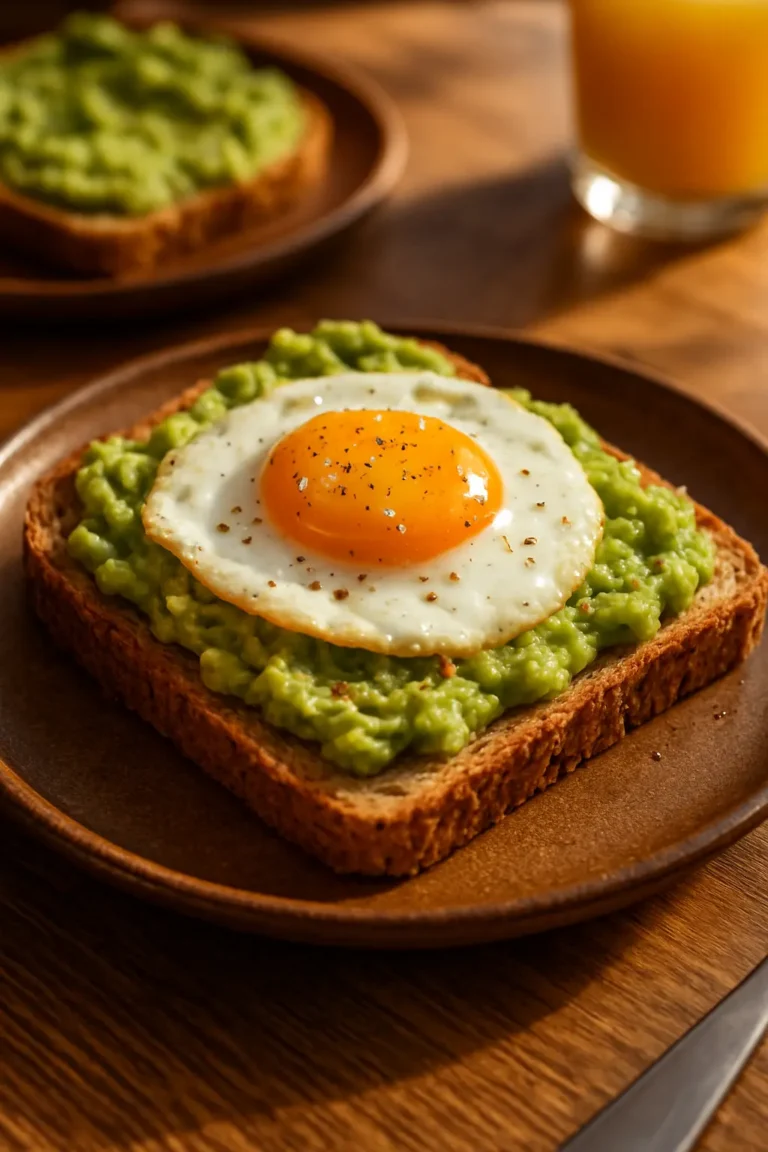Mediterranean Baked Feta Eggs – A Flavor-Packed Breakfast Delight
If you’re searching for a breakfast that’s both nutritious and deeply satisfying, Mediterranean Baked Feta Eggs might just become your new favorite dish. Combining rich, creamy feta cheese with perfectly baked eggs and aromatic herbs, this recipe brings together the best of Mediterranean flavors in a single, oven-baked dish. It’s quick, easy, and ideal for everything from busy weekday mornings to relaxing weekend brunches.
The secret lies in the simplicity of fresh, whole ingredients — a block of feta cheese, large eggs, a drizzle of extra virgin olive oil, and your choice of herbs like basil or mint. Whether served in pita pockets or on a plate with crusty bread, this recipe delivers both texture and taste. Looking for inspiration? Try this baked feta pasta recipe to discover more creative ways to use feta cheese in your meals.
In this article, we’ll dive into the ingredients, baking techniques, flavor variations, nutritional facts, and expert tips that’ll help you master this Baked Feta Eggs. You’ll also learn how to store, reheat, and even meal prep this Mediterranean breakfast delight.
Why Mediterranean Baked Feta Eggs Are a Must-Try
What Makes This Baked Feta Eggs Uniquely Mediterranean
The Mediterranean diet has long been praised for its heart-healthy benefits, and this recipe is a glowing example of why. It combines classic Mediterranean staples: olive oil, eggs, and feta cheese — all rich in healthy fats, protein, and flavor. The recipe leans on minimal processing and fresh ingredients, echoing the core of Mediterranean cooking traditions.
Unlike heavy, dairy-laden American breakfast casseroles, this dish stays light yet indulgent. The creamy feta melts just enough to mingle with the eggs, while herbs like mint and basil add a refreshing lift. It’s a perfect embodiment of “less is more.”
Health Benefits of Mediterranean Ingredients
Let’s break down the key components that make this dish both delicious and nourishing:
| Ingredient | Health Benefit |
|---|---|
| Feta Cheese | High in calcium and probiotics, lower in fat |
| Eggs | Rich in protein, choline, and essential vitamins |
| Extra Virgin Olive Oil | Anti-inflammatory, heart-healthy fats |
| Basil & Mint | Natural antioxidants, supports digestion |
This nutrient profile makes baked feta eggs suitable for low-carb, high-protein, or even keto lifestyles when served without bread. Plus, it’s gluten-free and vegetarian, which adds to its versatility.
The Rise in Popularity of Baked Egg Recipes
With food trends moving toward nutrient-dense yet easy-to-prepare meals, baked egg recipes are experiencing a surge in popularity. TikTok and Instagram reels have popularized feta-based bakes, making it easy for home cooks to replicate Mediterranean flavors without complex techniques.
This dish gained particular fame after baked feta pasta took the internet by storm. Now, a similar approach with eggs offers a protein-rich, savory version that fits any meal of the day. Don’t miss our avocado egg breakfast toast for another viral-worthy morning idea.
Ingredients Breakdown – Quality Matters

Choosing the Right Feta Cheese for Baking
Feta is the heart of this dish, so choosing the right kind makes all the difference. Skip the crumbled versions and go for a full 8-ounce block of feta cheese. Blocks retain more moisture and soften into a creamy, rich texture when baked. Authentic Greek feta, made from sheep’s milk or a blend of sheep and goat’s milk, has a tangier taste and silkier mouthfeel — perfect for a dish like this.
Feta from cow’s milk tends to be firmer and less flavorful, so read your labels. Look for PDO (Protected Designation of Origin) labels to ensure quality.
Why Extra Virgin Olive Oil Elevates Flavor
When you bake feta and eggs together, olive oil does more than prevent sticking. It enhances flavor, supports the cooking process, and adds a subtle richness. A good drizzle of extra virgin olive oil over the eggs and cheese before baking locks in moisture and boosts those classic Mediterranean aromas.
Using cold-pressed, high-quality olive oil will help the dish develop a slightly crisp top layer while keeping the interior creamy. You’ll taste the difference in every bite.
The Role of Fresh Herbs Like Basil and Mint
Herbs bring brightness to the richness of the cheese and eggs. While some might skip this step, garnishing with torn mint or chopped basil is essential if you want to capture authentic Mediterranean flair.
Basil offers a peppery sweetness that cuts through the creaminess, while mint provides a cool, aromatic contrast. Want a slightly earthy note? Try adding a bit of oregano before baking.
You can also combine herbs for more complexity. Just before serving, a handful of fresh leaves makes your dish taste and look gourmet.
Optional Add-ins for a Flavor Boost (Tomatoes, Spinach, Peppers)
Once you’ve mastered the base recipe, feel free to make it your own with simple add-ins. Here are some Mediterranean-friendly ingredients to layer before baking:
| Add-In | Flavor & Texture Benefits |
|---|---|
| Cherry tomatoes | Juicy bursts of acidity |
| Baby spinach | Earthy greens, great for balance |
| Red bell peppers | Sweet crunch and vibrant color |
| Kalamata olives | Salty tang for a briny twist |
| Red onion | Slight sweetness and caramelization |
Don’t go overboard — aim to keep the feta and egg balance as the primary focus. Need more ideas? Discover great add-ins in our Mediterranean Chickpea Salad Bowl Recipe, where similar ingredients blend beautifully.
Step-by-Step Guide to Making Baked Feta Eggs
Preparation Tips Before You Start
Before diving in, a few simple prep steps will ensure everything cooks evenly and tastes incredible. First, bring your feta cheese and eggs to room temperature. Cold ingredients from the fridge can alter bake time and result in undercooked whites or rubbery yolks.
Also, choose an 8×11-inch baking dish made of glass or ceramic. These materials distribute heat evenly, helping the eggs cook properly without over-baking.
Here’s a quick prep checklist:
- Preheat oven to 400°F (204°C)
- Lightly grease baking dish with olive oil
- Place block of feta in the center
- Crack 12 eggs evenly around the cheese
- Drizzle with 2 tablespoons olive oil
- Sprinkle with ¼ tsp salt and ¼ tsp black pepper
Baking Instructions and Ideal Temperature
Once prepped, slide the dish into the preheated oven and bake for 18–22 minutes. The exact timing depends on how you like your eggs — less time for runny yolks, more for fully set.
During baking, the feta will soften and begin to melt. Egg whites should be cooked around the edges but slightly jiggly near the yolks. Don’t panic if they appear underdone — residual heat from the dish will finish the cooking process.
Here’s a visual reference:
| Doneness Preference | Bake Time | Yolk Texture |
|---|---|---|
| Soft-set eggs | 18 mins | Runny to jammy |
| Fully cooked eggs | 22 mins | Firm |
Looking for more baking inspiration? Don’t miss our Mediterranean Roasted Chicken with Vegetables for another oven-friendly Mediterranean classic.
Common Mistakes to Avoid When Baking Eggs
Even simple recipes can go wrong if you’re not careful. Watch out for these common mistakes:
- Overbaking: This results in rubbery whites and dry yolks. Always check at the 18-minute mark.
- Using low-quality feta: Crumbled feta won’t melt as well or taste as creamy.
- Skipping olive oil: This affects both flavor and the evenness of cooking.
- Adding raw vegetables without prep: Watery veggies like spinach or tomatoes can release moisture and alter texture. Sauté or drain first.
Cooking Chart: Oven Temperature vs Bake Time
| Oven Temp | Bake Time Range | Result |
|---|---|---|
| 375°F | 22–26 minutes | Slower cook, softer yolks |
| 400°F | 18–22 minutes | Ideal balance |
| 425°F | 14–18 minutes | Crisp edges, firmer whites |
This dish is fairly forgiving, but consistency comes from practice. Want something equally simple but different? Check out our cucumber salad recipe to serve on the side.
Flavor Pairings That Work with Feta Eggs
Best Sides: What Goes Well With Mediterranean Feta Eggs
Pairing your baked feta eggs with the right sides transforms it from a simple breakfast into a full-on Mediterranean meal. The best part? Most of these accompaniments are easy to prep and highlight the dish’s flavors rather than compete with them.
Here are a few standout sides:
| Side Dish | Flavor Contrast |
|---|---|
| Roasted tomatoes | Acidic & juicy |
| Marinated olives | Salty & briny |
| Labneh with za’atar | Creamy with herbal tang |
| Sliced avocado | Soft and buttery |
| Greek salad | Crunchy, fresh, slightly tangy |
These combinations not only complement the creamy eggs and feta but also stay within the Mediterranean theme. For a breakfast that impresses guests or family, serve them together on a large platter for a shared brunch experience.
Looking for more ideas? Discover great sides like our crispy bang bang salmon for a hearty lunch pairing.
Bread Options: Pita, Sourdough, Flatbread
Bread is often the vessel of choice when serving baked feta eggs. Its role? To scoop, soak, and carry every bite of cheesy, eggy goodness.
Top Mediterranean bread options include:
- Pita Pockets – Stuff them with scrambled feta eggs and herbs for a handheld option.
- Sourdough Slices – Toasted for crunch and tang. Great for open-faced plating.
- Flatbreads – Thin and chewy, ideal for tearing and dipping.
You can lightly brush the bread with olive oil and toast it for added texture and flavor. Some even add garlic or sprinkle it with za’atar before toasting.
Fresh Toppings: Avocado, Tomatoes, Za’atar
Top your dish off with colorful and flavorful garnishes to boost both presentation and taste. These extras not only add visual flair but balance the richness of the eggs and feta:
- Avocado Slices: Bring in healthy fats and smooth contrast
- Chopped Cherry Tomatoes: Bright, acidic burst
- Za’atar Spice: Nutty and herbal flavor layer
- Lemon Zest or Juice: Cuts through the saltiness
- Crushed Red Pepper Flakes: Adds a kick for spice lovers
For even more Mediterranean flare, don’t miss our creamy mushroom pasta — another easy yet elevated dish to add to your meal planning.
Nutritional Value of Mediterranean Baked Feta Eggs
Calories, Protein, and Fat Content
When it comes to a filling, protein-packed meal that doesn’t weigh you down, Mediterranean Baked Feta Eggs hit the sweet spot. This dish is naturally rich in healthy fats and protein, making it a smart choice for fitness-conscious eaters.
Here’s an estimated nutritional breakdown per serving (1/6th of the recipe):
| Nutrient | Approx. Amount |
|---|---|
| Calories | 270–310 kcal |
| Protein | 17–20 grams |
| Total Fat | 21–24 grams |
| Carbohydrates | 2–4 grams |
| Fiber | <1 gram |
| Sugar | <1 gram |
| Sodium | 380–450 mg |
Feta is naturally lower in fat than other cheeses, and eggs provide all nine essential amino acids — a win-win for your morning plate. Combined with olive oil, which is rich in monounsaturated fats, this meal can help keep you fuller for longer without the sluggish feeling heavy breakfasts often bring.
Is This Recipe Keto or Low-Carb Friendly?
Absolutely. With just a few grams of carbs per serving (mostly from the feta and trace amounts from herbs or add-ins), this dish is ideal for anyone on a keto or low-carb diet. Just make sure to:
- Skip the pita if you’re watching your carb intake
- Serve with low-carb veggies like sautéed spinach or mushrooms
It’s also gluten-free by default — no swaps necessary.
Vitamins and Minerals from Eggs and Feta
This recipe isn’t just filling; it’s nutrient-dense. Here are some powerhouse micronutrients you’re getting in every bite:
- Vitamin B12 – Supports brain and nerve function
- Choline – Important for metabolism and cell health
- Vitamin D – Boosts bone health and immunity
- Calcium – Key for strong bones and heart health
- Phosphorus and Selenium – Crucial for energy and antioxidant support
Want to power up your day even more? Don’t miss our banana and peanut butter smoothie for a nutrient-packed breakfast beverage that pairs well with this dish.
Comparing to Other Breakfast Dishes
Let’s see how Mediterranean Baked Feta Eggs stack up against other common breakfast options:
| Dish | Protein | Fat | Carbs | Calories |
|---|---|---|---|---|
| Baked Feta Eggs | 17g | 22g | 3g | 280 |
| Breakfast Burrito | 13g | 29g | 37g | 450 |
| Avocado Toast (with egg) | 11g | 18g | 24g | 320 |
| Pancakes (2 with syrup) | 6g | 8g | 45g | 350 |
As you can see, baked feta eggs outperform most dishes in protein and fat while keeping carbs low — a clear win for balanced, feel-good eating.
Mediterranean Baked Feta Eggs Variations
Spicy Version: Add Harissa or Chili Flakes
Want to turn up the heat? Give your baked feta eggs a spicy Mediterranean twist with these easy additions:
- Harissa Paste – A North African chili blend that adds depth and smokiness
- Red Pepper Flakes – Sprinkle directly over eggs before baking
- Fresh Jalapeños or Serranos – Thinly sliced for a bold bite
Just a small amount brings out the savoriness of the feta while balancing the richness of the yolks. This version is perfect for spice lovers looking for a zesty start to the day.
Vegetarian Twist: Add Roasted Veggies
While the base recipe is already vegetarian, you can up the plant power by tossing in some roasted or sautéed veggies:
- Zucchini or Eggplant – Adds texture and fiber
- Cherry Tomatoes – Brings natural sweetness and acidity
- Spinach or Kale – A quick sauté ensures no excess moisture
- Mushrooms – Deep umami flavor to replace meatiness
Roast veggies ahead of time or use leftovers to make prep even quicker. Don’t miss our stuffed bell peppers with quinoa and veggies for more veggie-packed inspiration.
Protein Boost: Add Chickpeas or White Beans
For a heartier version that still fits a vegetarian lifestyle, stir in:
- Canned chickpeas – Rinse and drain well before use
- White beans – Like cannellini or Great Northern
- Crumbled tofu – A non-traditional but protein-rich twist
Bake as normal, but expect slightly longer cooking time due to the added volume. This option is great for brunch or post-workout meals.
Low-Cal Version: Reduce Oil, Add More Egg Whites
If you’re watching your calorie intake but still want a satisfying dish, try this:
- Use 6 whole eggs + 6 egg whites
- Drizzle only 1 tbsp of olive oil
- Skip or reduce pita bread
- Add fresh tomatoes or cucumbers to bulk it up
This version keeps the volume high but trims the fat and calories — a solid option for those on structured meal plans or calorie control.
Need more light Mediterranean recipes? Try our vegetarian stir-fry noodles for a healthy, high-flavor dinner idea.
Meal Prep and Storage Tips
How to Store Leftovers Without Losing Texture
Mediterranean Baked Feta Eggs store surprisingly well, making them ideal for meal prep. Once cooled, transfer leftovers into airtight containers and refrigerate within 2 hours of baking.
To maintain optimal texture:
- Store in shallow containers to avoid steam buildup
- Place a paper towel under the lid to absorb excess moisture
- Use within 3 days for best flavor and consistency
Avoid placing herbs or pita inside the storage container — add those fresh when reheating or serving.
Can You Freeze Baked Feta Eggs?
Yes, you can freeze this dish, though the texture of the feta may slightly change after thawing. The eggs also may become more rubbery if overcooked before freezing. To get the best results:
- Cool completely before freezing
- Portion into single servings for easy defrosting
- Wrap in foil or use freezer-safe glass containers
- Freeze for up to 2 months

When you’re ready to eat, thaw overnight in the fridge and follow reheating steps below.
Reheating Instructions for Best Results
To reheat without drying out the eggs or separating the feta:
| Method | Instructions |
|---|---|
| Oven | Preheat to 325°F, cover with foil, heat for 8–10 mins |
| Microwave | Place in a covered dish, reheat in 30-sec bursts |
| Skillet | Add a splash of olive oil, warm over medium-low heat |
Avoid high heat or long cook times — both can ruin the creamy texture and cause eggs to toughen.
You can also scramble the leftovers in a skillet for a slightly new dish. Scoop into a pita, top with herbs, and enjoy a quick Mediterranean-style wrap.
Best Containers for Meal Prep
For safe storage and easy reheating, choose containers that are:
- Oven- and microwave-safe (like tempered glass with lids)
- BPA-free plastic for cold storage
- Leak-proof and stackable for fridge organization
Want another meal prep-friendly recipe? Don’t miss our no-mayo potato salad with herbs — it’s refreshing and pairs well with this dish for a complete lunchbox combo.
When and How to Serve Mediterranean Feta Eggs
Breakfast, Brunch, or Dinner?
While originally designed as a breakfast or brunch dish, Mediterranean Baked Feta Eggs are flexible enough for any meal of the day. Thanks to its protein content and rich flavor, it satisfies morning hunger or makes a comforting light dinner.
Here’s a simple guide to when to serve it:
| Meal Time | Serving Style Suggestions |
|---|---|
| Breakfast | With toast, mint tea, and sliced avocado |
| Brunch | As part of a mezze platter with olives and hummus |
| Dinner | Paired with roasted vegetables or chickpeas |
No matter the time, this dish delivers satisfaction without leaving you overly full — one of the many perks of Mediterranean cooking.
Hosting Tip: Mediterranean Breakfast Spread
If you’re hosting a brunch or special gathering, this dish shines as a centerpiece. Here’s how to build an elegant yet simple Mediterranean breakfast board:
- Main: Baked feta eggs in a shallow dish
- Sides: Sliced cucumbers, cherry tomatoes, marinated olives
- Dips: Hummus, baba ghanoush, tzatziki
- Bread: Pita triangles, sourdough, lavash
- Extras: Crumbled feta, fresh mint, olive oil for drizzling
Serve everything on a wooden board or wide serving tray for a rustic, inviting feel. Your guests will love the flavors and the presentation.
Looking for a show-stopping dessert to finish? Don’t miss our strawberry crunch salad with champagne vinaigrette for a refreshing way to cleanse the palate.
Serving Suggestions for Guests
If you’re short on time, scoop the baked feta eggs into mini pita pockets for a grab-and-go option. Add fresh herbs and a squeeze of lemon juice to brighten each bite. This makes a great handheld brunch option for casual gatherings or potlucks.
You can also portion the dish into ramekins before baking for individualized servings — perfect for formal brunches or meal prep.
Kids-Friendly Adaptations
This dish is naturally family-friendly, but if you’re serving picky eaters:
- Skip the herbs and spicy toppings
- Use just egg whites or add shredded cheddar for familiarity
- Let kids build their own pita pockets with toppings they like
Not all kids love feta, so try blending half feta with a mild cheese like mozzarella for a creamier, more approachable flavor.
Mediterranean Baked Feta Eggs vs Other Egg Recipes
Comparison with Shakshuka and Menemen
If you love savory egg dishes, you’ve likely come across Shakshuka and Menemen, both Mediterranean-inspired favorites. But how do they compare to baked feta eggs?
| Dish | Main Ingredients | Cooking Method | Texture & Flavor |
|---|---|---|---|
| Baked Feta Eggs | Eggs, feta, olive oil, herbs | Oven-baked | Creamy, rich, cheesy |
| Shakshuka | Eggs, tomato sauce, peppers | Skillet-cooked | Spicy, saucy, bold |
| Menemen | Eggs, peppers, tomatoes | Scrambled in skillet | Soft, juicy, herbaceous |
Baked feta eggs offer a milder, creamier experience than either of the other two, and with fewer ingredients. It’s the perfect gateway dish into Mediterranean-style breakfasts for those who want big flavor with minimal spice.
What Makes This Dish Stand Out
What truly sets Mediterranean baked feta eggs apart is simplicity and versatility. It’s:
- Oven-friendly — hands-free cooking
- Customizable — works with countless add-ins
- Elegant yet effortless — serve it for guests or quick weekday meals
- Balanced — savory, cheesy, and satisfying without heaviness
It’s also low-carb and high-protein by design, making it a standout for both flavor and function.
Regional Twists: Greek vs Turkish Influence
Though baked feta eggs are broadly Mediterranean, the Greek influence shines through most. Feta is a staple in Greek cuisine, often paired with eggs, herbs, and olive oil.
If you lean into Turkish elements, you might:
- Add Aleppo pepper or sumac for tang
- Mix in sautéed onions and tomatoes before baking
- Serve with Turkish pide instead of pita
These small adjustments can transform the dish while keeping its core identity intact.
Should You Whisk the Eggs or Leave Whole?
A common question is whether to whisk the eggs before baking or leave them whole. Here’s the difference:
- Whole eggs: You get set whites and creamy yolks — better for presentation
- Whisked eggs: Scrambled texture with more uniform consistency
- Hybrid approach: Leave them whole while baking, then mix before serving (as this recipe suggests)
The third method combines the best of both worlds — beautiful in the dish, creamy and cohesive when served. This is why it’s often the preferred approach for Mediterranean-style baked egg dishes.
Frequently Asked Questions
How long to bake feta in the oven?
Feta should be baked in a preheated 400°F oven for 18–22 minutes, depending on the texture you want. Around 18 minutes yields softer, runnier eggs, while 22 minutes results in firmer whites and yolks. The cheese softens into a rich, creamy consistency without fully melting, which is exactly what you want.
What goes well with feta eggs?
Feta eggs pair wonderfully with pita bread, fresh herbs like basil or mint, and Mediterranean sides such as marinated olives, roasted tomatoes, and Greek salad. For something heartier, add sautéed spinach, avocado slices, or hummus on the side.
Can feta cheese be heated?
Absolutely. Feta cheese is safe and delicious when heated, especially in baked dishes. It doesn’t melt like cheddar or mozzarella but softens into a creamy, spreadable texture that blends beautifully with eggs or roasted vegetables.
What can you do with feta?
Feta is versatile:
Crumble it on salads
Bake it into casseroles or pastas
Stir it into egg dishes like this one
Blend it into creamy dips
Serve it on mezze platters
What is feta cheese known for?
Feta is known for its crumbly texture, tangy flavor, and briny richness. It’s one of the most popular cheeses in Mediterranean diets and is traditionally made from sheep’s milk or a mix of sheep and goat’s milk. Feta is a key ingredient in both cold and hot dishes across Greek, Turkish, and Middle Eastern cuisines.
Is feta good in an omelette?
Yes, feta works beautifully in omelets. Its strong, salty flavor stands up well to eggs and pairs especially well with ingredients like spinach, tomatoes, and onions. Crumble it into the eggs just before folding to keep its texture and flavor intact.
Elevate Your Breakfast with Mediterranean Baked Feta Eggs
There’s a reason Mediterranean Baked Feta Eggs have become a brunch-time favorite — they’re easy, flavorful, healthy, and highly customizable. Whether you follow the base recipe or jazz it up with veggies, spices, or herbs, this dish guarantees satisfaction every time.
Ready to try it out? All you need is a block of feta, a dozen eggs, good olive oil, and your oven. From there, the possibilities are endless — and delicious.
Don’t forget to check out our avocado egg breakfast toast if you’re craving more easy Mediterranean-inspired breakfast ideas.
Print
Mediterranean Baked Feta Eggs – A Flavor-Packed Breakfast Delight
- Total Time: 25 minutes
Description
Mediterranean Baked Feta Eggs is a simple yet elegant oven-baked breakfast dish made with a creamy block of feta, perfectly cooked eggs, and a drizzle of rich olive oil. This protein-packed recipe is infused with the bright flavors of fresh herbs like mint or basil and is ready in just 25 minutes. It’s naturally low-carb, gluten-free, and ideal for meal prep, brunches, or light dinners. Serve it solo or stuffed into warm pita pockets for a satisfying Mediterranean-style bite.
Ingredients
1 (8 oz) block feta cheese
12 large eggs
2 tablespoons extra virgin olive oil (plus more for greasing)
¼ teaspoon salt
¼ teaspoon black pepper
Fresh basil or mint, for garnish
Pita pockets, for serving (optional)
Instructions
-
Preheat oven to 400°F (204°C).
-
Grease an 8×11-inch baking dish with a little olive oil.
-
Place the block of feta in the center of the dish.
-
Crack the 12 eggs around the feta.
-
Drizzle olive oil over the eggs and feta.
-
Season eggs with salt and both eggs and feta with black pepper.
-
Bake in the preheated oven for 18–22 minutes, until whites are mostly set and feta is soft.
-
Scramble gently with a fork if desired, then garnish with mint or basil.
-
Serve warm, alone or scooped into pita pockets.
Notes
-
For a spicy version, add harissa or red pepper flakes before baking.
-
Add-ins like cherry tomatoes, spinach, or olives work well.
-
Scramble after baking for a creamy, unified texture.
-
This recipe is naturally gluten-free and keto-friendly.
- Prep Time: 5 minutes
- Cook Time: 20 minutes
- Category: Breakfast
- Method: Baking, Oven
- Cuisine: American
Nutrition
- Serving Size: 1 portion (1/6 of the baked dish)
- Calories: 290 kcal
- Sugar: <1 g
- Sodium: ~430 mg
- Fat: 23 g
- Saturated Fat: 9 g
- Unsaturated Fat: 13 g
- Carbohydrates: 0 g
- Fiber: 2.5 g
- Protein: 0.3 g
- Cholesterol: 18 g






